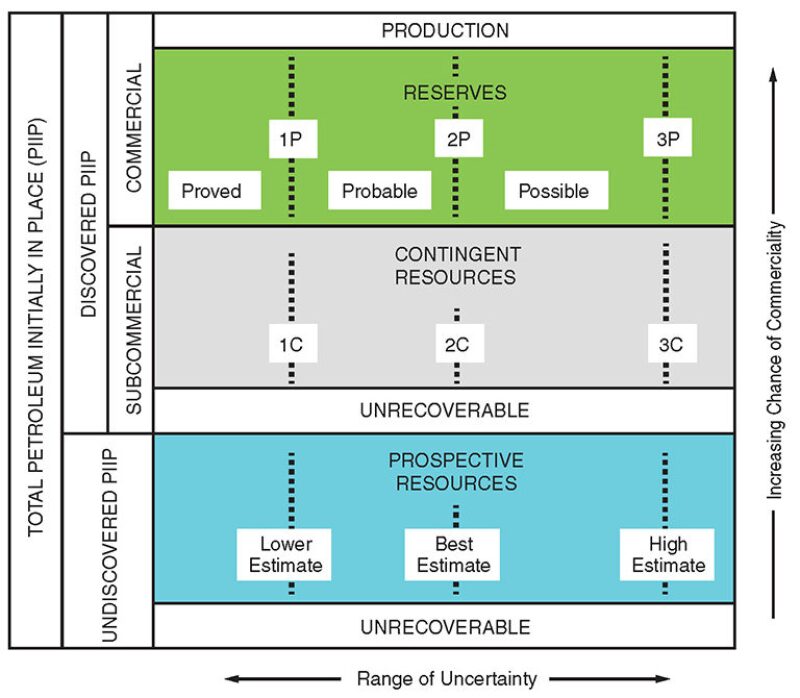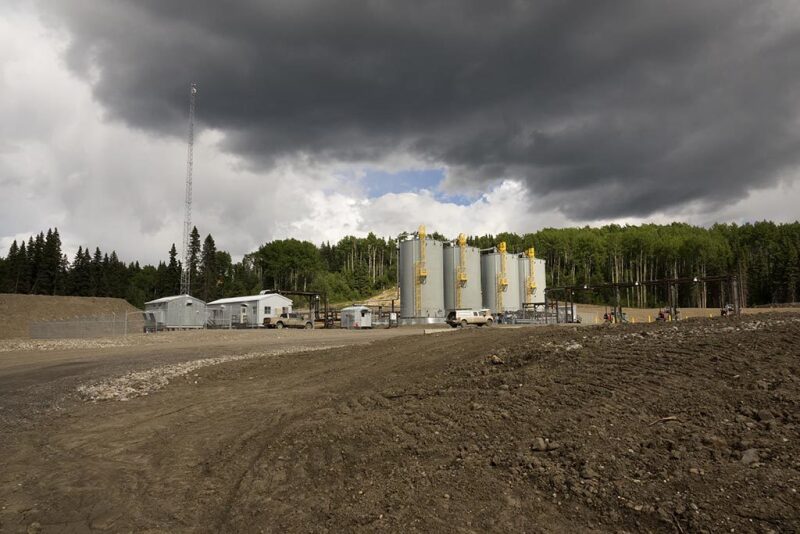Reserves- and resources-evaluation methods in unconventional reservoirs are different from those for conventional reservoirs. Depending on the phase of the resource play, a deterministic, probabilistic, or hybrid method may be required, with the most effective method evolving from deterministic toward probabilistic as the resource play moves from the early phase to the mature phase. To define the best method to use in a particular area, the evaluator should first identify the phase of the resource play and evaluate the amount of data available.
Introduction
For unconventional reservoirs, classification systems similar to those for conventional reservoirs can be used (Fig. 1). These systems include prospective resources, estimated contingent resources at discovery, followed by reserves, with maturation linked to the phases of the resource play.

As the resource play matures and technologies are screened, the development projects are better defined. Sections of the estimated resource volumes may be assigned to the contingent-resources subclasses using, for instance, the SPE Petroleum Resources Management System (PRMS) that recognizes the technical and commercial maturation toward reserves. Because unconventional accumulations are pervasive and developed with high-density drilling, well counts are typically large, making statistical analysis of well performance feasible. As a result, probabilistic techniques may be more appropriate to understand the uncertainty ranges of estimated ultimate recovery (EUR) per well and associated confidence levels. Extrapolation of results requires careful consideration of the geology and engineering characteristics of a particular area to predict well productivity. This analysis could be more intricate than that for conventional reservoirs because of the short production history and the particularly complex displacement mechanisms that may be happening in these reservoirs.
For the estimation of resources in both conventional and unconventional reservoirs, it is important to understand the effect of reservoir uncertainties and development plans. Geological uncertainties such as gross rock volume, porosity, permeability, hydrocarbon saturation, and reservoir continuity have a large effect on in-place volumes. Engineering uncertainties (e.g., relative permeability, capillary pressures, viscosities, aquifer properties) affect the physical processes in the reservoir during the production of hydrocarbons, determining gas/oil recoveries and, finally, the ultimate reserves/resources.
Deterministic methods use a single value for each parameter used in the resources estimation (for instance, in the in-place volumes and recovery factors). The prospective resources can be classified as low, best, and high, with discovered resources volumes classified as 1C, 2C, and 3C. The reserves volumes then can be classified as “proved,” “probable,” or “possible” in the incremental approach, or 1P, 2P, or 3P in the cumulative approach, depending on the level of uncertainty.
In probabilistic methods, the statistical uncertainty of individual reservoir parameters is used to calculate the statistical uncertainty of the in-place and recoverable resource volumes. Probabilistic methods are tailored to handle uncertainty in the different parameters required to estimate reserves and resources. Estimations of recoverable resource quantities using probabilistic methods allow the inclusion of the associated uncertainty in each parameter that applies to both conventional and unconventional resources.
Unconventional Resources
To reduce the uncertainty in reservoir properties in unconventional accumulations, large sampling density with wells and testing is required. Variations in reservoir properties are likely to happen in these very large areas (for instance, permeability in coalbed methane), requiring detailed geological characterization by use of well data. This is clearly crucial before any resources-estimation exercise can start.
Monograph 3 from the Society of Petroleum Evaluation Engineers (SPEE) lines up four main stages in the evaluation process with four phases of maturity in a resource play, identifying the phases as early, intermediate, statistical, and mature. Depending on the maturity of the resource play, different amounts of data are available to the evaluators and, therefore, different methodologies would be appropriate for reserves and resources estimation. If well data are very limited, deterministic methods would be more appropriate. If large data sets with enough production data exist, then probabilistic methods could be used.
The early phase is typically characterized by geological exploration, wide well spacing, and minimal well production. Because production data are sparse, deterministic methodologies are best suited. In the intermediate phase, well counts have increased significantly and many new wells are exploiting areas around existing production. Total well count is usually high, but many of these wells are still not “analogous wells” according to SPEE’s Monograph 3 because operators continue to experiment with the completion techniques. All of these issues make statistical analysis difficult, but deterministic or hybrid methods are well suited for the job.
Once sufficient well data are acquired, statistical analysis becomes both meaningful and useful. SPEE calls this phase the statistical phase. Most wells are exploitation wells, although operators continue to examine the effects of well spacing and minor changes in completion procedures. In the mature phase, the reservoir extent is reasonably delineated and well density is very high. Well count is obviously high enough for statistical analysis but may not be very helpful because most proved undeveloped (PUD) locations are already infill locations. Production interference may be noticed during this phase, and more-sophisticated modeling methods including numerical simulation may be applied to estimate reserves.
Deterministic Methods
Deterministic methods should be used at the early and intermediate phases of maturity, when limited amounts of data exist. These methods, such as the ones used in the Canadian Oil and Gas Evaluation Handbook (COGEH), are based on drilling spacing units (DSUs). In these methods, PUD resources are defined to be within one drainage radius of a producing or tested economic well. “Probable” resources are defined to be typically immediately adjacent to proved DSUs, which typically corresponds to being two drainage radii away from PUD resources. The categorization of “possible” is two to three drainage radii away from a producing or tested economic well.
Resources are defined beyond the “possible” areas and up to six section radii away with reasonable expectation of economic production if no faults or geological barriers are encountered. This approach helps the evaluator to restrict the areas that can be claimed as discovered resources after drilling exploration and appraisal wells, leaving the rest of the areas as prospective resources until wells are actually drilled and hydrocarbons discovered.
Some level of extrapolation is allowed by the COGEH for reserves by the use of bracketing to extrapolate between PUD locations.
When only a few wells have been drilled, it is appropriate to use a deterministic method to calculate the reserves areas. A combination of engineering methods should then be used to estimate EURs. Integrated engineering methodologies should be used to estimate and validate estimates.
Some authors have published intermediate approaches—hybrid methods—for reserves and resources evaluation that lie between pure deterministic and fully probabilistic methods. These methods can still use well-development spacing conventions such as those found in the COGEH to estimate the areas of confidence around the drilled wells. High-, medium-, and low-confidence areas are mapped on the basis of well information. Uncertainty ranges are defined—larger uncertainty in less-well-defined areas and lower uncertainty in the areas bounded by drilling. EUR uncertainty ranges are also defined and applied to each corresponding confidence area. The main contribution of these methods is that they actually provide the link between the reserves areas and the approved development project as required by the PRMS.
Probabilistic Methods
The PRMS and US Securities and Exchange Commission rules issued in 2009 both allow the use of probabilistic methods for reserves estimations and specifically state that, if probabilistic methods are used, there should be at least a 90% probability that the quantities actually recovered will equal or exceed the 1P estimates. For 2P reserves, there should be at least a 50% probability that the actual quantities recovered will equal or exceed the 2P reserves estimates. For 3P, there must be at least a 10% probability that the actual quantities recovered will equal or exceed the sum of proved, probable, and possible estimates. Reservoir uncertainties can be defined by a probability distribution. When Monte Carlo methods are used to generate probability functions, a random sampling of the input reservoir uncertainty distributions is performed to estimate the in-place reserves (Fig. 2).
Different categories of reserves or resources are estimated using the final probability distribution by selecting the confidence levels (P90, P50, and P10) required for each reserves category (1P, 2P, and 3P). When using deterministic methods, the estimation of the downside (low) and upside (high) recoverable reserves is difficult because, when selecting parameters in deterministic models, practitioners tend to select and aggregate the upside of the different parameters or the downside, creating reservoir models that are often at much less than P90 or more than P10 confidence levels. Resulting cumulative probability functions are then used for various quantitative risk-analysis and decision-making methods to optimize development plans. This demonstrates the enormous value of probabilistic methods in helping to understand and quantify the effect of major uncertainties and the confidence levels associated with the reserves or resources estimates.
The method described in SPEE Monograph 3 is complex and requires comprehensive well counts, well-by-well performance analysis, statistical analysis, and geological/engineering analysis of the study area to validate the geological subset criteria. It is based on the assumption that existing production wells can be used to predict the performance of undrilled locations away from the direct offset wells.
This article, written by Special Publications Editor Adam Wilson, contains highlights of paper SPE 164820, “Probabilistic and Deterministic Methods: Applicability in Unconventional Reservoirs,” by C. Coll, SPE, and S. Elliott, BG, prepared for the 2013 EAGE Annual Conference and Exhibition/SPE Europec, London, 10–13 June. The paper has not been peer reviewed.

